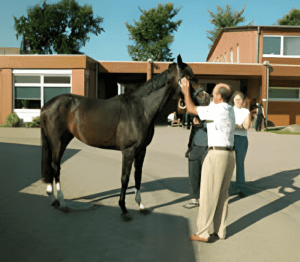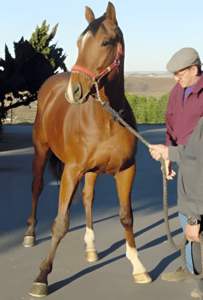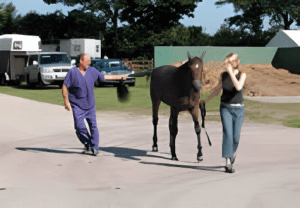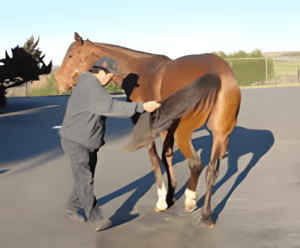Equine Neurological Examination
Diagnosis for Neurological Problems
It all starts with the neurological examination; this examination can be performed by your veterinarian. Whenever possible, a neurological examination should also have a complete lameness examination at the same time. The same pathogenesis that causes developmental problems in the cervical area can also cause problems in many other joints, especially the stifles, hocks, and fetlocks.
The neurological exam tests are not complicated, but the interpretation of the results does require some experience and good observation. We recommend that the exams be videotaped so other examiners - often in the eastern states - can render an opinion without having to travel. The tapes can also serve as a reference to determine if there is any clinical improvement with treatment. The following are some of the more basic tests and what is normal and abnormal about each.
- Back withdrawal: Pressure is placed over the back and pelvis to determine if the patient resents the pressure. A normal horse will not react, but a "Wobbler" will withdraw by depressing the spine in a squatting position. This is not a sign of pain but a sign of weakness as a result of nerve damage. Horses with painful spines do not usually squat because squatting would result in more pain.
- Tail and anal tone: The normal horse should have a tone in the tail when it is elevated. A horse with spinal cord problems will have a very flaccid tail, especially if the damage is in the lumbar or sacral areas. The anus should pucker when stimulated and not remain wide open.
- Panniculus or skin sensation: The sensation along the entire spine is tested with the end of a ballpoint pen on both the left and right sides. A normal horse should move the skin and muscles as though being irritated by a fly. Horses with spinal problems often do not react in the area that is damaged. This test can be quite variable as some horses are very stoic while others react as though they were going to have an injection.
- Mobility of the neck: The horse is quietly and gently encouraged to bend his neck so that the nostrils reach behind the shoulder. This should be repeated on both sides. The use of a carrot or a handful of grain will often encourage the patient to reach the neck back behind the shoulder. A horse with a painful neck, cervical fracture, or an arthritic vertebra will refuse to bend the neck or will try to twist around to the carrot by moving the legs. Some horses with severe problems will become more ataxic (drunken) after this test. Others may have a difficult time eating either off the ground or from an elevated hay net.
- Placement tests: The front legs are taken one at a time and crossed over the front of the other leg or placed in a wide stance. Normal horses should instantly replace their legs to the proper position, while horses with spinal cord problems can take a long time to recognize their awkward stance. This test should be repeated on the opposite side and can also be done on the hind legs in subtle cases. We do not recommend doing this on very obvious "Wobblers" as there is some risk to the patient, handler, and examiner when trying to perform this on horses with very poor balance.
- Tail sway: While the patient is being walked by an experienced handler, the tail is pulled to each side by the examiner. Normal horses resent the tail pull, but wobblers are easily pulled to the side while walking, and when the pressure is released, they overcorrect or sway to the other side.
- Tight circles: The patient is walked in a very tight circle pattern. A normal horse has the outside front foot placed in front of the inside front foot and the inside hind foot placed in front of the outside hind foot. Horses with spinal cord problems will be confused and often reverse this order or pivot on the inside foot instead of lifting the leg. They will also swing the hind leg very wide (circumduction). The more severely affected horses may even step on themselves, almost trip and fall, and pivot on the inside foot.
- Hills: The patient is led up and down an incline with the head in a normal position, and then again with the head elevated. Normal horses place their hind feet flat on the ground and do not elevate the front feet (hypermetria) when going down hill. When coming uphill, the normal horse should also walk with flat rear feet. Abnormal horses walk downhill as though they have been tranquilized (truncal ataxia) and will knuckle over on the hind fetlocks. The patient will walk on the toes coming up hill and swivel the toes and hocks laterally, trying to get enough strength to get up the hill. Walk the patient with the head elevated, and if the horse is affected, the signs should be even easier to see.
9. Backing: The patient is backed for at least 10 steps. It is best for the examiner to observe from the side. Watch if the horse has any delay in the hind legs or drags any toes, as the neurological horse will do either one or both.
This test should be repeated with the head elevated. Affected patients will show more pronounced dragging of all four toes.
10. Free exercise: If the patient is not severely affected, then he/she is allowed to run free in a paddock. Horses with spinal cord abnormalities bunny hop with the hind legs at a canter, will often be on the incorrect lead behind, and will knuckle over behind when trying to stop. Mildly affected horses have a very impressive, animated gait at the trot that usually makes dressage owners salivate.
11. Hopping: This test should only be done by an experienced examiner on soft footing. Affected horses will almost fall if encouraged to hop with one front leg held off the ground. Some horses have a strong side and a weak side. If the horse hops when the left front leg is off the ground and refuses to hop when the right leg is off the ground, we assume that the left side is affected.
12. Blindfold: The patient is led up and down an incline with the head in a normal position, and then again with the head elevated. Normal horses place their hind feet flat on the ground and do not elevate the front feet (hypermetria) when going down hill. When coming uphill, the normal horse should also walk with flat rear feet. Abnormal horses walk downhill as though they have been tranquilized (truncal ataxia) and will knuckle over on the hind fetlocks. The patient will walk on the toes coming up hill and swivel the toes and hocks laterally, trying to get enough strength to get up the hill. Walk the patient with the head elevated, and if the horse is affected, the signs should be even easier to see.
Assigning a Grade Level to your Horse after the Neurologic Exam
After the neurological exam is complete, the degree of ataxia your horse showed is assigned a grade. This grade uses the Mayhew system and assigns a number from 0 to 5. This grade will usually be expressed as "2 out of 5", which means grade 2, or "<3/5," which means less than a grade 3. These evaluations are not performed on horses being ridden. The characteristics of each grade are as follows;
-
Grade 0 – normal
-
Grade 1 – minimal neurological deficits noted with normal gaits and requires manipulative tests (crossing legs, tail sways, tight circles, walking up and down hills, blindfolding, backing, response to a dull object).
-
Grade 2 – mild abnormal gaits seen at a walk (walks like a patient that has been sedated) and more obvious response to the manipulative tests. Patients can be performing successfully, but when asked, they have trouble with lead changes, going down hills at a trot or gallop, stumbling, being heavy on the forehand, requiring a lot of leg to maintain propulsion, knuckle over when stopping, bunny hop behind when cantering, and drag hind toes a lot at a trot.
-
Grade 3 – Easy to see at a walk, look like a drunken camel at a trot, very obvious at a canter, but they do not fall.
-
Grade 4 – Very ataxic – will fall, especially in tight circles or backing. Usually, they will refuse to go any faster than a walk.
-
Grade 5 – Recumbent – may not even be able to become sternal, even with encouragement.
After the neurological exam is complete and there is a high index of suspicion that the cervical area may be the source of the problems, a series of radiographs (x-rays) are taken with the patient lightly sedated. The radiographs are then examined for fractures, collapsed intervertebral disc space, misalignments, narrowed spinal canal measurements, and arthritic articular facets.



